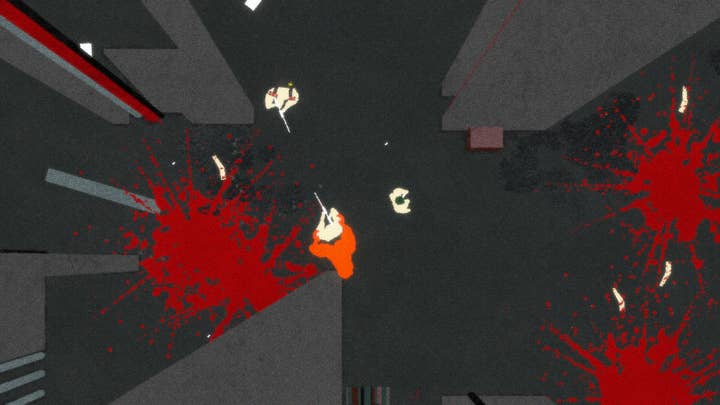The evolution of Ape Out
Gabe Cuzzillo explains how a song helped defined the aesthetic for his BAFTA-winning action game
When Gabe Cuzzillo first started work on the game that would become Ape Out, he had a specific vision of what the game would be. But that vision was not one of a hulking gorilla escaping its well-armed captors with a gameplay-driven jazz percussion soundtrack.
Instead, he tells GamesIndustry.biz the idea was to make a stealth game about time travel with a featured mechanic like that of Super Time Force, where players replay levels again and again, each time playing through alongside recordings of all their previous runs. However, there were some problems realizing that vision from the outset.
Cuzzillo describes himself as "extremely new to game development" in late 2013, when he began work on the project. He had just released his first game, Foiled, a fighting game he'd created in six months in Game Maker despite having never coded before. For his second game, he decided to learn Unity.
"I couldn't get a lot done at first, so the first couple months were extremely, extremely slow," Cuzzillo says.
"The goal of the experiment was to try and create a top-down game that had a sense of physicality to it"
By the time he had a character up and running around on the screen, the time travel conceit had fallen away.
"The goal of the experiment was to try and create a top-down game that had a sense of physicality to it," Cuzzillo says, "and the original version of that was a stealth game where you were going to be on walls all the time, so you'd press yourself up against walls, slink along walls, push off walls, grab walls, peek around corners..."
Cuzzillo started building around "pushing" and "grabbing" as the key gameplay concepts. So naturally, if the game included guards, players should be able to push and grab them as well.
"Then it was weird if you were running around grabbing guards and throwing them into walls [disabling or killing them] when you were just a normal bald man, so I thought it might be a good fit for a gorilla escaping captivity," Cuzzillo says.
Along the way, he was also developing the game's visual style.
"It was something I iterated on for a long time," Cuzzillo says. "After 6-8 months of playing around in Unity and developing the idea and mechanics, I was just trying to find a style I felt like I could accomplish as a non-artist... I was looking at a lot of Olly Moss posters at the time and Saul Bass posters of course, and just trying to get that sense of materiality and physicality into the game's art. It was something that felt doable and I also hadn't really seen done that way before. It just took a lot of time and a lot of iterations to get it there."
He also knew early on that he would want to limit the player's sight somehow. But unlike the finished game -- which gives the player a simultaneous line-of-sight view from 360 degrees around the character -- the original idea was to limit the player's view to a cone of about 120 degrees in the direction the character was facing, which Cuzzillo approvingly says "had this paranoid feeling to it."
Around the same time he had the revelation of swapping his normal bald man out for a gorilla, Cuzzillo says he become "super obsessed" with the Pharaoh Sanders song "You've Got to Have Freedom," listening to it on a loop while working on the game.

"That started to permeate the feeling of the game and the aesthetic I was shooting for," he says. "Eventually I decided I was going to try to communicate that feeling with this game, and that clarified the design of the game for me... The identity of the game and everything else just kind of spun out from those original creative decisions and just trying to capture the vibe of the song."
(Anyone who finishes Ape Out can decide for themselves how well the game captured that vibe, as "You've Got to Have Freedom" plays over the end credits.)
While Sanders is a jazz saxophonist, Cuzzillo was drawn to drums as a focal point of the game's audio. He also wanted the audio to be reactive to the gameplay, citing Everyday Shooter as a major inspiration.
Cuzzillo says the cymbal crash that happens when the player kills an enemy in Ape Out was one of the first sound effects in the game, but credits collaborator and former Harmonix project director Matt Boch with expertly executing on the idea.
"Matt then did an incredible, insane version of that [reactive cymbal clash idea] where there's a simulated drummer pulling from thousands of drum patterns and thousands of samples of real drums being played and reacting in a way I didn't really think was possible and don't think has been done before," Cuzzillo says. "That's all Matt. That's all his work."
Cuzzillo is no less appreciative of his other major collaborator on Ape Out, Bennett Foddy (QWOP, Getting Over It with Bennett Foddy). He's currently working with both of them on a variety of prototypes to find the next big project.
"Probably we're going to keep making games together, at least for now," Cuzzillo says. "I'm in a really great spot where Ape Out made me enough money where I can be fine for a couple years, and Bennett and Matt are great people to be collaborating with. There's nobody who I respect or like working with more than them. I'm basically where I want to be right now."

